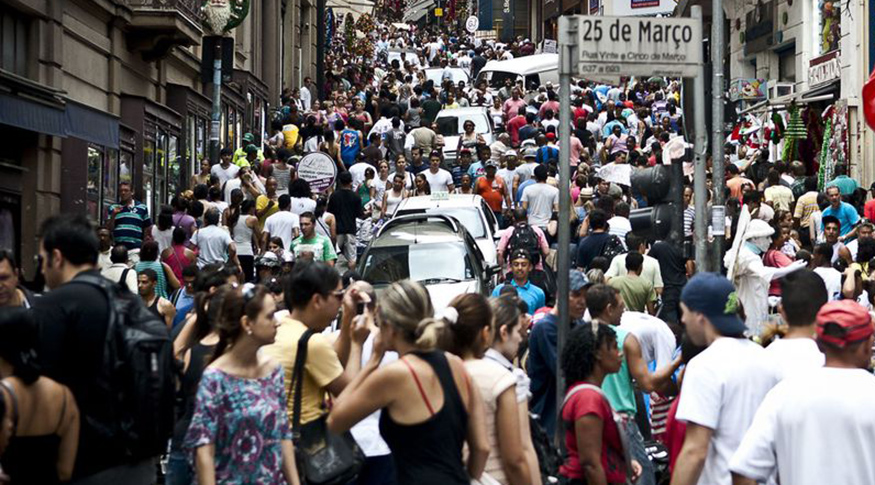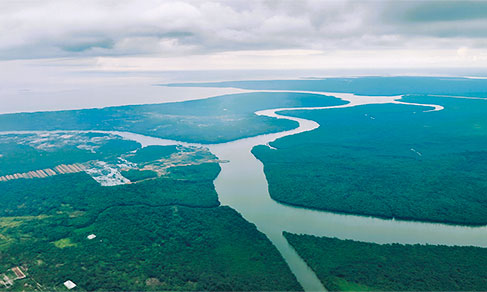2022 Census
2022 Census: 87% of the Brazilian population lives in urban areas
November 14, 2024 10h00 AM | Last Updated: January 07, 2025 04h19 PM
Highlights
- In 2022, 177.5 million people (87.4%) out of the total 203.1 million people in the Brazilian population lived in urban areas, whereas 25.6 million lived in rural areas.
- From 2010, when the level of urbanization had reached 84.4%, there was an increase of 16.6 million people living in urban areas and a decrease of 4.3 million people living in rural areas.
- Against 2010 and 2022, ein urban areas, the population increased at a rate of 0.82% a year, while in rural areas, the oberved pace was acceleration in decrease until a total of -1.27%.
- The highest percentages of urban populations were found in the Southeast (94.44%) and Central West (91.35%), followed by the South (88.24%), North (78.47%) and Northeast (77.64%).
- The rural population, in turn, for the first time, recorded decreases in all the Major Regions. The North, which had recorded an increase of 8.07% between 2000 and 2010, now represents a loss of 11.02%. The same was observed in the Central West, which recorded an increase of 2.03% dof the rural population between 2000 and 2010 and, in the period between 2010 and 2022, a drop of 10.59%.
- The 2022 Population Census registered a total of 13,433,611.2 kilometers covered, which is equivalent to 335 the diameter of the Earth in rural and urban areas of low density of construction.
- Considering only non-repeated data, the extent of routes covered reached 3.2 million kilometers for the same territorial area listed above.
- With 939,143,56 km in routes, the Northeast Region was the most covered one among the Major Regions.
- Among the Federation Units, Minas Gerais had the longest route covered, 461,955.59 km.
- Rio de Janeiro (RJ) hadneighborhoods in the country in 2022, led by Campo Grande, with 352,356 residents.

According to the 2022 Population Census, of the total country's population, 203.1 million people, 177.5 million (87.4%) lived in urban areas, whereas 25.6 million (12.6%), in rural ones. Against 2010, when the level of urbanization had reached 84.4%, there was an increase of 16.6 million people living in urban areas and a drop of 4.3 million living in urban ones.
“The release presenting the division of urban and rural areas guided by urban morphology and by the functionality of occupation is an innovation in relation to the 2022 Census data, since the IBGE used to consider only legal urban lengths defined by municipal administrations, which are sometimes out of date. Based on updated orbital images, our updaters identified the extent of urban and rural areas for statistical purposes and classified each enumeration are according to their territorial status. Such mappping has made possible to count the population by urban or rural status of the housing unit," the survey analyst, Felipe Leitão, explains.
These data are found in “2022 Population Census: Mapping of Definitive Enumeration Areas", released today (14) by the IBGE, by means of digital vector files of the eunmeration areas that represent the Brazilian territory, where it is possible to carry out a number of analysis and technical studies, with customized analyses of territories according to users' interests.
Each enumeration area is identified according to its location in the political administrative division of the country - Municipalities, Districts, Subdistricts - and represents a group of localities used as references in the contextualization of statistical data - Neighborhoods, Towns, Villages, Urban Centers, Favelas and Urban Communities, Indigenous and Quilombola Areas, among others. Unprecedently, the mapping is presented together with data on the formationof enumeration areas, and that facilitates the recomposition of data comparability between Census data of 2022 and the previous edition, 2010, thus contribution to comparative studies at local scale.
Also released today, by means of digital files, is the "2022 Population Census: Aggregated Results by Enumeration Area: Population results," which presents data obtained from the census questionnaire for the resident population - such as sex, age, color or race, literacy status, among others – and for housing units – such as water supply, garbage disposal, type of sewage disposal - for Enumeration Areas. Another release is "2022 Population Census: Enumeration Route", which shows the routes covered by the enumerators working in the field during the census operation, also evidencing the efforts made by the Institute to carry out the Census operation.
The release event will be held at 10 am at Casa Brasil IBGE, at Palácio da Fazenda, located downtown Rio de Janeiro. It will be streamed live on Digital IBGE. The data will also be available on Sidra, on the Interactive Geographic Platform (PGI) and on the Census Overview, except for the routes covered by the enumerators, which will be available in the format Keyhole Markup Language (KML).

“Between 2010 and 2022, downward trend of increase of the Brazilian population was maintained, at a rate of 0.52% in the year. In urban areas, the population increase reached a rate of 0.82% a year, whereas in rural areas the pace of decrease reached a rate of over 1%, with -1.28% in 2022.”
The highest percentages of urban population were found in the Southeast (94.44%) and Central West (91.35%), followed by the South (88.24%), North (78.47%) and Northeast (77.64%). The North Region recorded the biggest change in urbanization rate between 2010 and 2022 (4.96 p.p.), with a change from 73.53% to 78.47%.
The Central West region (19.21%) recorded the biggest change in the urban population between 2010 and 2022, followed by the North (16.78%), South (13.61%), Northeast (9.34%) and Southeast (7.28%).
The rural population, for the first time, recorded drops in all the Major Regions in Brazil. The North Region, which had recorded an increase of 8.07% between 2000 and 2010, now dropped by 11.12%. The same was observed in the Central West Region, with a decrease of 2.03% of the rural population between 2000 and 2010 and a decrease of 10.55% between 2010 and 2022.
The remaining Major Regions, which had been on a downward trend regarding rural population between 2000 and 2010, remain on the same trend: Southeast Region, 16.93%; Northeast Region, 14.37% and South, 14.92%. It is worth mentioning that, from the total loss of 4,257,656 of persons in rural areas, 2,049,144 (48.13%) correspond to the Northeast Region.
Eight of the 10 most populous neighborhoods in the country are in Rio de Janeiro
According to the Population Census, the Brazilian territory had, in 2022, 17,576 neighborhoods. Among the ten most populous in the country, eight were located in Rio de Janeiro. Campo Grande is number one in the ranking with 352,356 residents, followed by Santa Cruz (249,130 residents), Jacarepaguá (217,462 residents) and Bangu (209,302 residents).
The first neighborhood in the ranking located outside Rio de Janeiro is Cidade Industrial de Curitiba, in Curitiba (PR), with 172,510 residents. Pimentas, in the city of Guarulhos (SP), with 168,232 residents, is the only representative of São Paulo state. Other neighborhoods in Rio are in the list: Realengo (167,027 residents), Guaratiba (159,888 residents), Barra da Tijuca (151,603 residents) and Tijuca (142,909 residents).
The IBGE classifies as neighborhoods only the divisions or internal zones of municipalities legally established by the municipal authority. In the 2022 Population Census, the population living outside neighborhoods, that is, in municipalities whose neighborhoods were not formally established or in areas not served by neighborhoods, amounted to 119,431.359 people.
Also, Brazil had 468,097 enumeration areas, distributed among 5568 municiplaities and in the Federal District. The country also has a total of 10,670 districts and other 643 subdistricts, in 54 municipalities.
Minas Gerais and Bahia lead ranking of routes covered by enumerators in Federation Units
The 2022 Population Census obtained, automatically, approximately 560 million geographic coordinates that represent spots in the routes covered by the enumerators, during the process of registration and/or update of the visited addresses. Throughout the data collection period, a total of 13,433,611.2 kilometers were covered in the entire rural and urban areas of low density of buildings in the country, which is equivalent to a movement of 335 turns around the Earth.
At the end, after data treatment, which excluded the overlapping of back and forth movements through the same path, the total extension of routes was a little more than 3.2 million kilometers, a significant decrease in the total registered at first.
Among Federation Units, Minas Gerais had the longest route, 461,955.59 km. It was followed by Bahia (350,609.33 km), São Paulo (251,802.02 km), Rio Grande do Sul (203,305.53 km) and Mato Grosso (199,294.12 km). The largest Federation Units, Amazonas represented only 2.6% f the total covered I the country, with 84,306,12 km. These data are related to the density of occupation of the traversed territory, being directly related to the number of streets and roads existing in each one for the territorial area being analyzed.
Considering the original route traversed, Brasília leads in terms of the longest extent, with 55,617 km, in spite of being the 259th municipality in terms of territorial area, being followed by Porto Velho (RO), with 22,577 km in the original route, and Petrolina (PE), with 22,425 km.
As for treated data, the longest extent was traversed in the municipality of Corumbá (8,713.12 km), followed by São Felix do Xingu (8,011.97 km).
“The routes registered during the operation had as their main purpose to offer a new instrument of collection supervision to survey coordinators, aiming at contributing to guarantee universal coverage of sectors treated by the enumerators,” explains Eduardo Baptista, manager of the IBGE Address List.
The capture of route coordinates was carried out by means of mobile devices used in the field by enumerators. This function was implemented in the application of collection so as not to make it difficult or require extra work time from the enumerator, as the registration of species and the interviews were priority tasks. Once the application is started, a geographic coordinate is captured every five seconds, by means of an automatic functionality.

Northeast Region had the longest route traversed
During the 2022 Census, the enumerators covered a total extent of 3,224,256.40 km, being 939,143.56 km in the Northeast Region, which represents 29.1% of the total extent covered in the country. It is followed by the Southeast Region, with 808,304,73 km, representing 25% of the total Census routes. The Central West Region follows, with 510,478,01 km of routes (15.8% of the total), North Region, with 490,505.49 km (15.2% of the total), and, finally, the South Region, with 475,824.61 km of routes covered, which represent 14.7% of the total.
Besides the route of enumerators, the publication presents information related to mapping and the aggregated enumeration areas, which can be accessed here. É possível acessar a tabela de comparabilidade entre o Censo Demográfico 2010 e o de 2022, além da malha de distritos, subdistritos, o arquivo vetorial dos bairros e mapas municipais estatísticos. Os arquivos ainda apresentam recortes por sexo e idade, cor ou raça.
More about the survey
“Mapping of Enumeration Areas” encompasses files in the formats GeoPackage (.gpkg), open source for Geographic Information Systems, allowing exchange of open files; and Shapefile (.shp), format for vector data storage; and Keyhole Markup Language (.kml), format for visualization of spatial data in terrestrial viewers. It is stored as a group of related files and has a feature class.
The files are available for the entire country separated by Federation Units for districts, subdistricts, neighborhoods and enumeration areas and present comparability information among the enumeration areas of the 2010 Census.
Attached to the Mapping of Enumeration Areas one can find Municipal Statistical Maps in GeoPDF format, used as a reference for the conduction of the 2022 Population Census. Available for all the municipalities in the country, in this edition the maps have, whenever possible, high resolution orbital images for better visualization of data. The GeoPDF allows the georeferenced visualization of the map in environments of Geographic Information Systems.
“Aggregated Results by Enumeration Areas: Population Results” makes available aggregated results by districts, subdistricts, neighborhoods and enumeration areas for a group of more than 3 thousand variables, with some of the covered topics being: population (age, sex and color or race); literacy; household composition and reported death; Indigenous population (sex, age, literacy, birth records and characteristics of housing units); quilombolas (sex, age, literacy, birth records and characteristics of housing units); and occupied private housing units, occupied improvised housing units and collective ones.
The release “Enumeration Route” shows the routes covered by the enumerators working in the field (streets, roads, rural tracks, etc.) in each enumeration are based on coordinates captured by mobile GPS devices along the way.




















